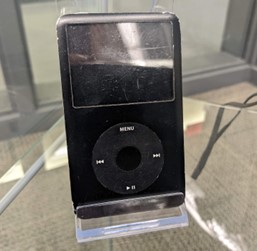Digital Music Player
Manufacture Period: 2007-14
Model: iPod Classic 80GB
Apple is one of the most famous brands worldwide, with ubiquity in branding, product developments, and marketing. Being considered one of the most valuable companies in the world — with an estimated revenue of $260 billion at the time of writing this article — it is my assumption that nearly everyone reading this will be somewhat familiar with the brand.
This is the 6th generation iPod Classic with 80 GB of storage, being first sold on September 5th, 2007. The iPod line was introduced on November 10, 2001, with the product line becoming known as the iPod Classic and the extension into new lines, such as the iPod Shuffle, iPod Nano, and iPod Touch. Although not the first portable digital music player, the distinctive marketing, design and associated software made the product stand out from the crowd. The marketing of iPods, via the use of dancing silhouettes against brightly coloured backgrounds were once synonymous with the brand, and a form of popular print advertising. Apple even made an homage to their decades old advertising approach for the AirPods in 2022. Prior to the introduction of the iPhone and other smartphones into the market in 2007, iPods had a 68% market share on portable music players. Unfortunately, this new technology quickly devalued the convenience of iPods and by 2010 sales were overtaken by the iPhone. The product line of iPod Classics was discontinued on September 9, 2014, with the iPod Touch being the last new generation from the line in 2019, before the product family was discontinued in May 2022. With over 20 years of production, the iPod family is the longest running line Apple has retired.
The company itself began in April 1976 by Steve Jobs and Steve Wozniak with the development of the Apple I, which later became the Apple II. This was a notable technological change in terms of bringing computers with colour graphics into the home. This boom in sales carried over into 1980, with $117 million in sales and the company making the decision to be publicly traded. The 80s saw both founders leaving the company, and a change of priorities within the company. By 1996, after a series of poor marketing decisions, many speculators predicted Apple’s doom. This led to the board of directors asking for Steve Jobs to return as interim CEO in 1997, before he became the official CEO in 2000. Through the 90s, Apple made a licensing agreement to use Microsoft’s software, and introduced several successful product line, (the iBook, iPod, and Macbook). Though the greatest success, both in popularity and revenue, has been the iPhone. With a 15.6% marketshare on mobile phones in Q1 of 2022, Apple has consistently been one of the top three phone providers.
On loan from Emily Hotton
Monday, January 30, 2023 in Media Museum
Share: Twitter, Facebook




